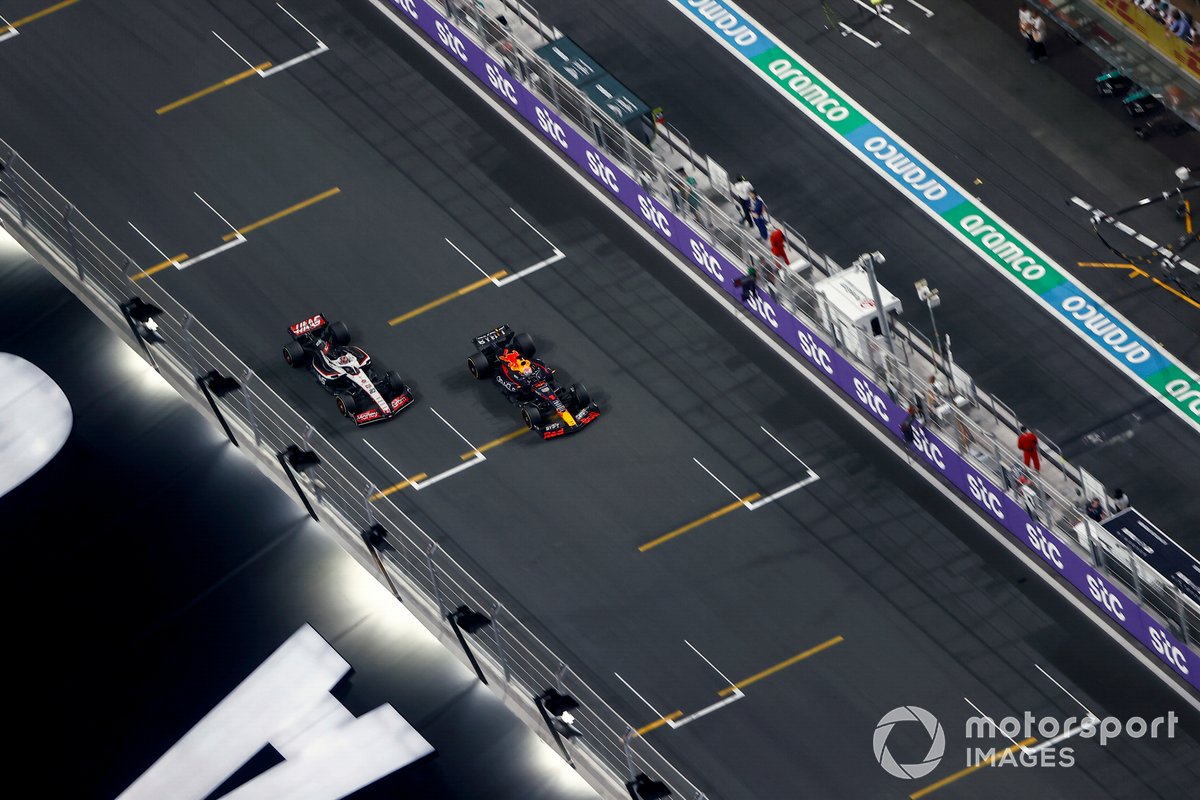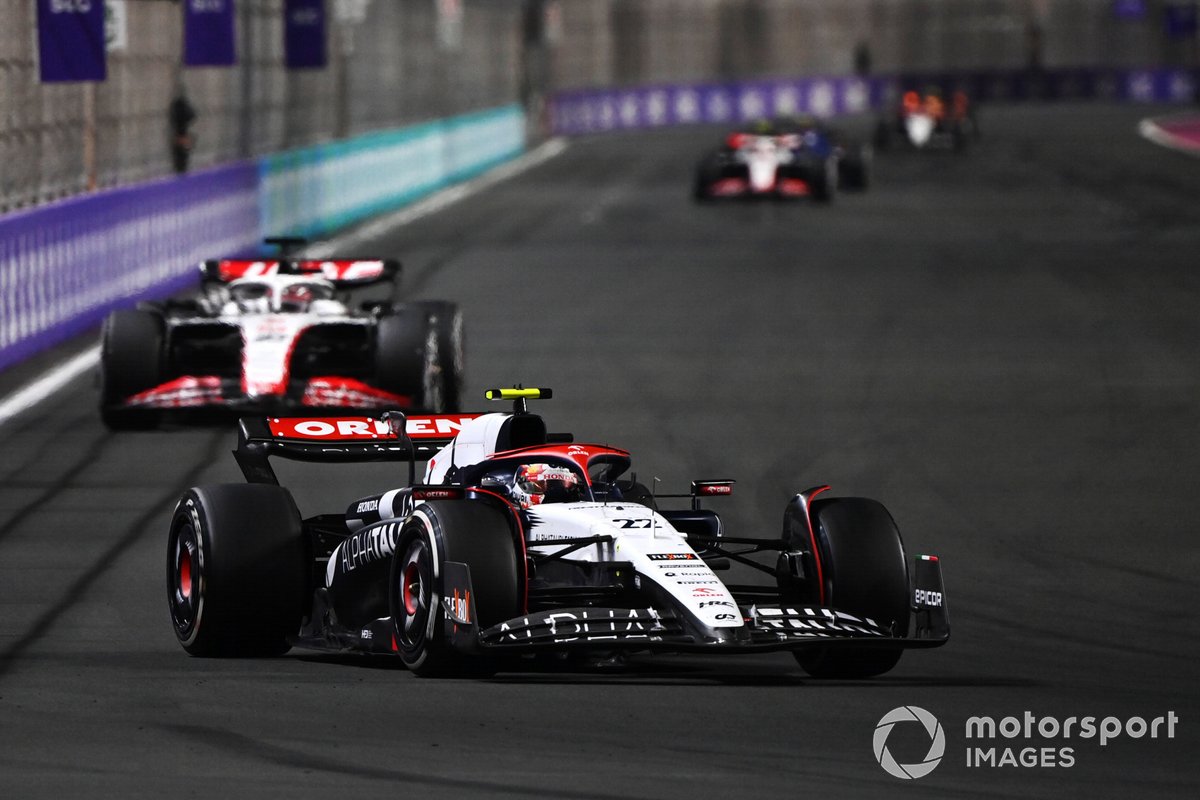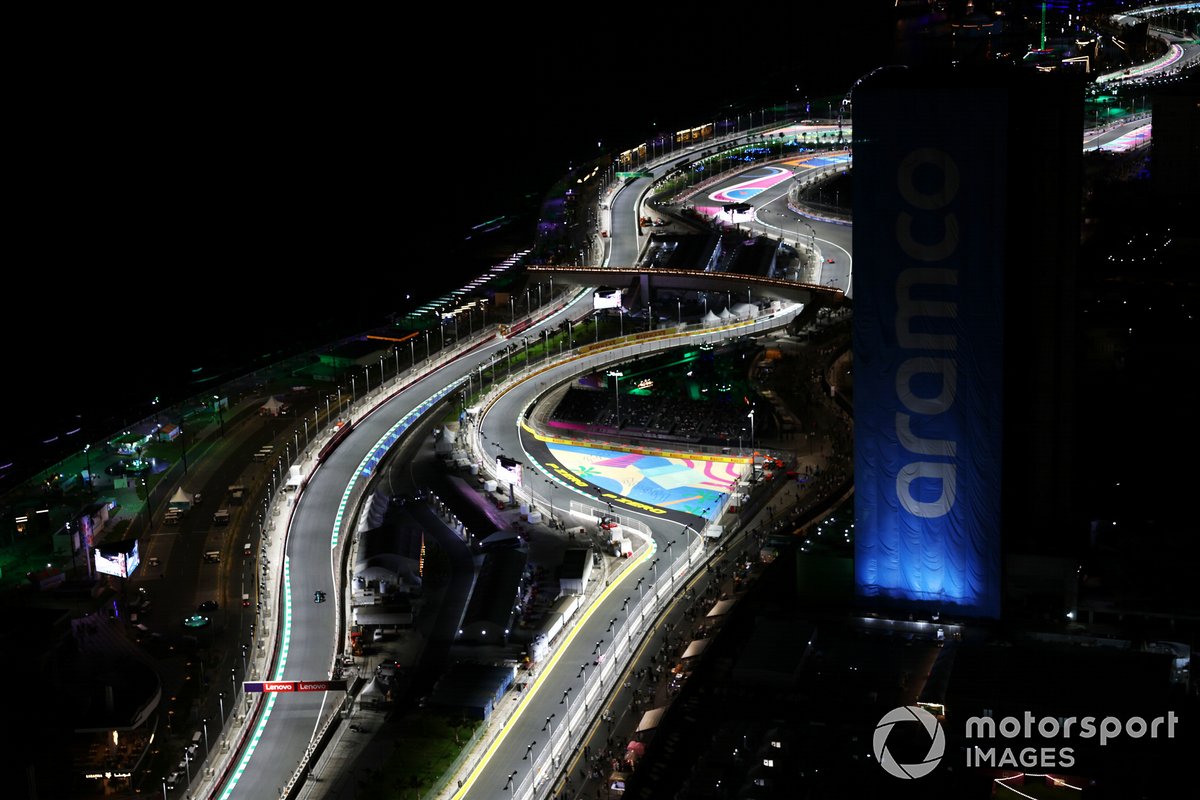
For the second race in a row, Formula 1 witnessed a Red Bull domination, as Sergio Perez led home Max Verstappen in the third Saudi Arabian Grand Prix.
But, it was a somewhat different story from Bahrain, as – for the first time in their time as team-mate's – Perez took the top spot with Verstappen just one step down. That was in large part down to the Dutchman's qualifying driveshaft failure, which meant he started down in 15th and had to put in another charging race to score big points.
But that he didn't overhaul Perez too has raised faint hopes of a title fight between the two, particularly interesting given their Brazil team orders saga last year and the confusing radio messages with Red Bull as they chased the fastest lap.
That, and plenty more, is what we learned from another blast around the Jeddah streets…
1. Perez's late Jeddah pace raises hopes of title fight with Verstappen

Christian Horner described Perez's win as the Mexican's "best grand prix" drive, which rather forgets his sublime 2020 Sakhir GP recovery after being turned around there by Charles Leclerc.
In this one, Perez continued what has rather becoming a bad habit of slower cars getting ahead with a poor start. He re-passed Alonso relatively easily on lap four of 50 given Red Bull's mighty top speed allied with DRS, but it was an error nevertheless.
Thereafter, however, Perez was excellent and deserves considerable praise. He dropped a driver as canny as Alonso at the safety car restart and then delivered excellent pace to stop Verstappen from eating into his late advantage once the Dutchman was up to second. That alone is brilliant and has raised the prospect of the pair possibly engaging in an intra-team title fight.
To do that, Perez will need to be consistently excellent, which is second nature to Verstappen. And he, let's not forget, was only on a recovery drive after his qualifying driveshaft problem. But in a season of Red Bull domination, many F1 fans surely need something to hope for to keep interest levels up.
2. Red Bull has maintained its straight-line prowess against Ferrari

One of the big talking points heading to Jeddah was how Ferrari might perform compared to Red Bull given it had adapted the SF-23's concept compared to its F1-75 predecessor to be better in a straight line, at the price of slightly lower peak downforce levels. Given this track's long straights and high-speed overall nature, it was a key test for both teams.
But only one came out a clear winner: Red Bull. The RB19 was tracked with a near 2mph advantage down the main straight in qualifying, while ahead of the final corner its drivers were braking with a 4mph gap to the best the Ferraris could manage. The red cars were consistently powering out of the corners faster than their rivals, but the gain didn't last long.
Given its reliability struggles in Bahrain it was logical to wonder if the Ferrari engine is now running turned down from maximum power, as it was for the second half of 2022. Team boss Fred Vasseur coyly said post-race, "we were with the same set-up in quali and the race". This concerns the one power mode rule only – not if Ferrari was avoiding its best settings overall.
But whatever the outcome, this was far from the speed test result the Scuderia needed.
3. Bahrain wasn't just a one-off for Aston Martin and Alonso

Behind Red Bull's supremacy, Aston Martin's climb up the competitive order was the next biggest talking point from the season-opener. But in Bahrain Fernando Alonso had warned that the team's added drag compared to the other 'Class A' teams – especially Ferrari – could prove to be a real headache in Jeddah.
Well, based on what happened in Sunday's race, Aston can gain considerable confidence that it will be regularly able to take on the red cars and the black ones fielded by Mercedes too. Although Leclerc's grid penalty negated another mighty qualifying performance from the Monegasque, which meant we never got to see what he could do starting ahead of Alonso, the Ferrari cars struggled badly for tyre life – particularly on the hards.
Aston, for the second race in succession, did not. Alonso was able to gain time on the chasing Russell even right at the race's very end as they pressed on with the Spaniard's penalty saga looming.
There might've been no chance of stopping the Red Bulls coming by when they did, but Alonso's qualifying speed and tyre preservation prowess here suggests if Aston can get everything right and Red Bull doesn't, or perhaps a tight track such as Monaco is the competition, the chance to nick a sensational win is surely on.
4. Ferrari is realising it's not even second best anymore

The extension of Aston's tyre management strength in 2023 is just how much this factor is hampering Ferrari. The SF-23 is clearly still a force over one lap given Leclerc's qualifying showings so far this year, but both he and Carlos Sainz faded badly on the final stint on the hards.
This was after Leclerc had appeared to be racing strongly on the softs that aided his charge from his 12th place grid spot in stint one, while Sainz could at least stay with the Mercedes and Astons ahead on the mediums. But Ferrari's struggles on the hards after they lost out stopping before the safety car apparently suggests to Sainz that his squad isn't even now F1's second best on overall potential – a far cry from this time 12 months ago.
"[I'm] a bit surprised because after Friday and before the weekend, I thought that we had a chance of being the second force here in Jeddah," said Sainz. "But I think that last stint on the hard proves that we still have a lot of work to do, that we have a weakness in the race and that we need to wait for the developments to come to see if we can improve that weakness."
5. Russell is again starting strongly against Hamilton at Mercedes

Well, at least they didn't have to worry about porpoising this time around, but for George Russell and Lewis Hamilton once again in Jeddah neither was a factor in the lead fight for Mercedes. That said, they were very much in contention for the final podium spot, which Russell, briefly, had.
Although Alonso's second penalty was later overturned, the brief results swing that meant Russell unexpectedly had to show up for the post-race press conference highlighted that for the second year in a row, he is starting a season strongly compared to Hamilton. Russell felt that, overall, Mercedes "made a step in the right direction" on its deficit to Red Bull with set-up adjustments to the W14, while he also enjoyed a "really strong qualifying".
His fourth place there to edge out Lance Stroll's faster Aston meant he started ahead of Hamilton for the second successive race. That alone is impressive, but it's combined with Russell then driving away from the seven-time world champion late in Sunday's race. They were of course on off-set tyre strategies, but Hamilton had the race pace legs on Russell in Bahrain and it was a different story for round two.
Hamilton does not currently feel "connected to this car", which is robbing him of confidence compared to his team-mate. But that shouldn't detract from the fine start Russell has made to his second Mercedes season.
6. A long-understood rule is not as clear as many thought

Alonso held his hands up to "my mistake" which meant he lined up too far to the left of his grid box for the start, but it kicked off a much bigger incident later on. This was because Aston's rear jack man touched Alonso's AMR23 before the five-second hold he had to serve at his pitstop as a result of his grid infraction had been completed – similar circumstances to Alpine's Esteban Ocon getting a 10s penalty in Bahrain.
But Alonso's was retracted over three hours after being issued as Aston successfully argued that an understanding that front jacks being used to guide cars into stops – including touching them when penalties were being served – meant the rule in question stating "[a car] may not be worked on until the car has been stationary for the duration of the penalty" did not stand up.
In essence, its definition was too loose and Aston also had evidence of "seven different instances where cars were touched by the jack while serving a similar penalty to the one imposed on [Alonso] without being penalised", per the stewards' document announcing Alonso's second penalty was rescinded.
The FIA will review the rule in question ahead of the Australian GP next up, but the whole incident has kicked off yet another rules implementation saga for the governing body, this time over something that had long been understood as a hard-and-fast issue by F1 observers.
7. The FIA's penalty swiftness is still not good enough for some

Also surrounding Alonso's second penalty drama was how long it took to initially be issued – coming in 20 minutes after the race had finished and after the Spaniard had completed the podium ceremony. To have that many spectators and television viewers unaware of the subsequent change, had it been upheld, created a considerable fuss.
"[If] you wait for after the podium, there is something really wrong in the system, but it's the way it is," said Alonso.
"I feel sorry for the fans. But I really enjoyed the podium. I had the trophy, I had pictures, I celebrated with the champagne and now to have 15 points or 12 points it really doesn't change much for me. But it's a bit sad for the FIA. It's [also] not fair for George, because I guess the Mercedes sponsors would love to be on the podium…"
Ultimately, it's best to get the right result no matter how long it takes, especially in such a complex motorsport division. But the initial frustration at how long the Alonso second penalty saga took – five hours and 12 minutes overall from race start to the final result being issued – was understandable.
8. Tsunoda can cope with big pressure

Given he had two embarrassing and big crashes marring his second F1 season in 2022 and AlphaTauri starting so badly off the pace in 2023 that team boss Franz Tost shockingly declared "I don't trust" the team's engineers, pressure is really amping up for third-year driver Yuki Tsunoda. The likeable Japanese racer edged new team-mate Nyck de Vries in Bahrain, then so nearly and brilliantly claimed a point in Jeddah.
Getting very fortunate timing around the safety car period aided Tsunoda, as he was the first driver in a position to pit when it started. The gain got him up to eighth and ahead of the Alpine pair and while they inevitably demoted him, for 20 laps he then defied Kevin Magnussen. Only the Dane's considerable bravery thrusting his Haas's nose to Turn 1's inside (actually in defence given he'd passed Tsunoda at the final corner seconds before) ended their battle.
Nevertheless, Tsunoda should be encouraged by the patience and determination he showed taking on a faster car. Now, he needs to demonstrate such brilliance consistently and the typical 'third-year' step the top drivers manage.
9. McLaren's early 2023 woes continue

Oh, how the cliche 'it never rains but it pours' applies to McLaren at the start of 2023.
After its reliability shocker in Bahrain, this time crash damage misfortune rocked the orange team. Just after the start, a piece of Oscar Piastri's MCL60 right-side endplate flicked up and smashed the left side of Lando Norris's nose – after the former had clashed with Pierre Gasly – and forced both McLarens to pit in successive laps.
Those very early stoppages confined them to fighting at the back when the car package had the pace to make Q3, as Piastri did. Norris did not after making a poor error glancing the wall at the final corner and damaging his steering on the way to a Q1 exit.
At least Piastri is showing the signs of his fantastic junior formula potential in getting stuck in with Norris during their late-race battle with Logan Sargeant. And with hards that were approaching 50-laps old. Such a pity it was over 15th place.
10. The high-speed Jeddah track still has issues even with 2023 changes

Although F1 escaped from its visit to Jeddah without a massive crash this time, the 3.8-mile track's high-speed nature is still something of a problem.
Crashes are always a risk when it comes to racing such fast machines on a walled track, but when it comes to practice and qualifying Jeddah's blind corners continue to be a danger according to some drivers. This is especially considering the huge speed differential potential for drivers on slow or fast laps in sessions. And it actually follows the race organisers opening up some corners, moving barriers, adjusting kerbs and making the track wider in places overall, all for the third Saudi event in 15 months.
"The walls being further away is a bit better," said Magnussen. "You can see further back in your mirrors, but it's still not very far. So, sometimes if your engineer isn't telling you, then it's a bit tricky [with rival cars approaching fast and often unsighted].
"You're still looking at mirrors. You can still see three, four seconds behind, which isn't a lot. But there's still time enough to sort of get out of the way."
'Sort of' just isn't good enough overall for F1…







